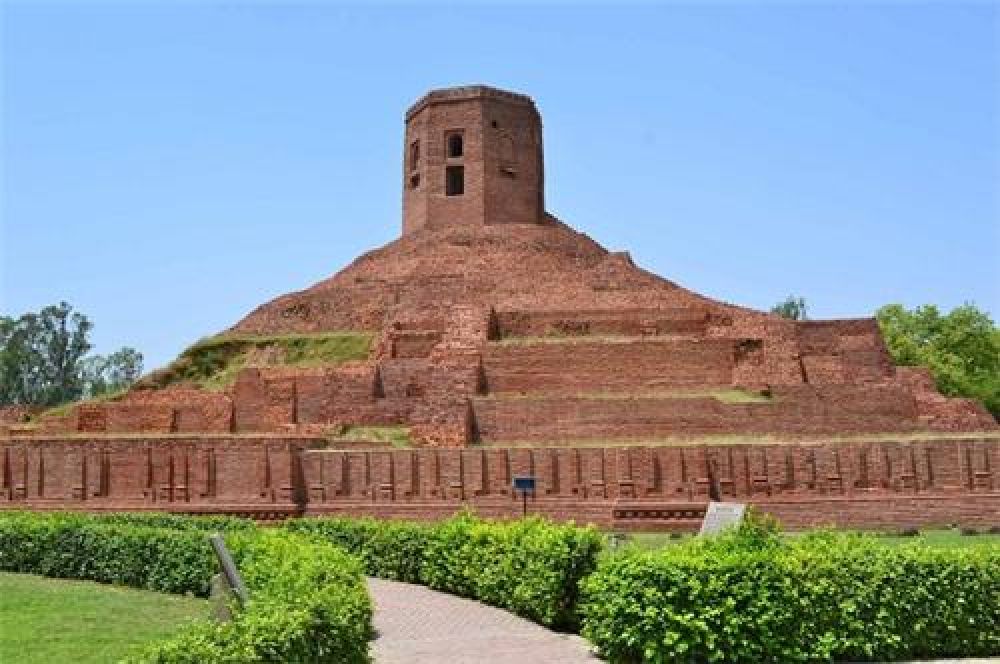

The Chaukhandi Stupa is a significant historical and Buddhist site located in the town of Sarnath, near Varanasi in Uttar Pradesh, India. Sarnath is where Gautama Buddha first taught the Dharma after his enlightenment. The Chaukhandi Stupa is believed to mark the spot where Lord Buddha met his first five disciples. The tourism history of this site is deeply intertwined with the spread of Buddhism and the pilgrimages undertaken by followers and scholars alike.
Originally built as a terraced temple during the Gupta period (4th to 6th century CE), the Chaukhandi Stupa was later modified into its present shape in the 16th century by the Mughal Emperor Akbar's governor of Bengal, who added an octagonal tower to commemorate the visit of Humayun, the great Mughal ruler. This site stands as a testament to the confluence of several periods in Indian history and the syncretic nature of its culture.
Archaeologically, the stupa is significant for understanding both the religious and secular aspects of ancient Indian civilization. It has been excavated and studied various times, ensuring its place in the history of Indian tourism.
The advent of modern tourism to Sarnath, including the Chaukhandi Stupa, began in earnest with the establishment of the Archaeological Survey of India (ASI) during British rule. Since then, the site has attracted tourists and pilgrims from around the world. In recent years, concerted efforts have been made to improve the tourist experience at Sarnath and thereby enhance the profile of Chaukhandi Stupa.
The latest tourism trends point to an increased interest in experiential tourism and sustainable practices. Visitors are not only content with seeing the historical sites but are also keen on understanding the context, participating in cultural activities, and ensuring that their travels do not adversely affect the local ecology and culture.
The site has also adapted to the digital age with the introduction of Virtual Reality (VR) experiences that allow visitors to see reconstructions of the site's past glory. This combines both the educational and experiential aspects sought after by modern tourists.
Government Initiatives such as the 'Swachh Bharat Abhiyan' (Clean India Campaign) and the 'Adopt a Heritage' program have led to better maintenance and facilities at the Chaukhandi Stupa, thereby attracting more international and domestic tourists. The site also benefits from the International Buddhist Conclave, a biennial event promoting Buddhist heritage across India.
In addition, with tourism becoming one of the key sectors for economic development, infrastructure around Sarnath is rapidly developing. There are better connectivity, improved accommodations, and professional tour operators offering comprehensive packages, including visits to Chaukhandi Stupa.
When tourists visit the Chaukhandi Stupa, they are greeted by the impressive architecture and the quiet serenity of the place. The tranquil environment coupled with the historical significance provides a contemplative experience, ideal for those seeking peace and spiritual insights.
Apart from the stupa itself, visitors can also explore the Sarnath Archaeological Museum, which houses many important finds from the excavations, including the famed Ashoka Pillar with the four-lion capital, India's national emblem.
To further enrich their experience, tourists often combine their visit to Chaukhandi Stupa with other nearby Buddhist heritage sites, such as the Dhamekh Stupa and the Mulagandhakuti Vihara, as well as participating in a guided meditation or attending a lecture on Buddhist philosophy.
As an important site in Buddhist pilgrimage and Indian history, the Chaukhandi Stupa of Sarnath remains a beacon of spiritual significance and a key pillar in the Indian tourism sector, attracting visitors from across the globe year after year.